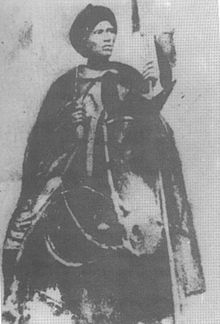| Maad a Sinig Kumba Ndoffene Fa Ndeb Joof King of Sine | |||||
|---|---|---|---|---|---|
 The King of Sine Kumba Ndoffene Fa Ndeb Joof fully dressed in his ceremonial robe and mounting a horse. In his left hand, it looks like he is holding the flag of Sine. | |||||
| Reign | circa 1898 - 1924 | ||||
| Coronation | Crowned c. 1898 at Diakhao Kingdom of Sine, part of present-day | ||||
| Predecessor | Maad a Sinig Mbacke Ndeb Njie | ||||
| Heir-apparent | Maad a Sinig Mahecor Joof | ||||
| Prime Minister | His Great Jaraff (equivalent of prime minister) was Bandiougour Sène.[1] | ||||
| Born | Diakhao, Kingdom of Sine, present-day | ||||
| Died | 21 December 1923 at Diakhao | ||||
| Issue | El Hajj Farba Diouf | ||||
| |||||
| House | The Royal House of Boureh Gnilane Joof | ||||
| Religion | Serer religion | ||||
Maad a Sinig Kumba Ndoffene Fa Ndeb Joof, also known as Kumba Ndoffene Joof II or Bour Sine Coumba Ndoffène Fandepp Diouf, was a King of Sine (in present-day Senegal).[2] Maad a Sinig (also: Mad a Sinig or Maad Sine) translates as "King of Sine", Maad meaning king in the Serer language.[3][4][5][6][7] The surname Joof is the English spelling in the Gambia. Diouf is the French spelling in Senegal (see: Joof family).
There is no consensus regarding the exact date that Maad Kumba Ndoffene Fa Ndeb succeeded to the throne. According to some, he reigned from 1898 to 1924,[8][9] which correlates with the written sources available at the time.[10] Other historians propose that, he reigned from 1897 or 1898 to 1923.[11] This version agrees pretty much with the oral tradition of the Serer people. According to Serer tradition, the king was very ill before his death and ruled for 27 winters (27 years) before his successor - Maad a Sinig Mahecor Joof succeeded to the throne. When the King died, there was a period of mourning and it took a little while to prepare for the Coronation ceremony of Maad a Sinig Mahecor Joof according to Serer custom and tradition.[12][13] Maad Mahecor Joof ascended to the throne in 1924,[9] more precisely, according to some, on 28 January 1924. Regarding the year Maad a Sinig Kumba Ndoffene Fa Ndeb Joof died, there is consensus that it was in 1923,[14] more specifically on 21 December 1923 at Diakhao.[15]
Maad a Sinig Kumba Ndoffene Fa Ndeb Joof should not be confused with his great uncle[16] Maad a Sinig Kumba Ndoffene Famak Joof, also known as Coumba Ndoffène I, who reigned from 1853 to August 1871.[17] The prefix Famak (or Fa mak) means "the elder" in the Serer language. Fa Ndeb (also :Fandepp, Fa ndepp or Fandeb) means "the young" in Serer. These prefixes were later additions (during and after the reigne of Maad a Sinig Kumba Ndoffene Fa Ndeb) to differentiate the two Kings of Sine who shared the same name and surname.[18]
- ^ Klein, Martin A., Islam and imperialism in Senegal: Sine-Saloum, 1847-1914, Stanford University Press, 1968, p. 195. ISBN 0804706212
- ^ Klein, Islam and imperialism in Senegal, pp. 7, 173.
- ^ Oliver; Fage & Sanderson. The Cambridge History of Africa, Cambridge University Press, 1985, p. 214. ISBN 0521228034
- ^ Faal, Dawda, Peoples and empires of Senegambia : Senegambia in history, AD 1000-1900, Saul's Modern Printshop, 1991, p. 17
- ^ Ajayi, J. F. Ade & Crowder, Michael, History of West Africa, vol. 1, Longman, 1985, p. 468. ISBN 0582646839
- ^ Galvan, Dennis C. The State Must be Our Master of Fire, University of California Press, 2004, p. 270. ISBN 9780520235915
- ^ Diouf, Marcel Mahawa, Lances mâles: Léopold Sédar Senghor et les traditions sérères, Centre d'études linguistiques et historiques par tradition orale, Niamey, 1996, p. 54.
- ^ Villalón, Leonardo Alfonso, Islamic society and state power in Senegal : disciples and citizens in Fatick, Cambridge University Press, 1995, p. 200. ISBN 0521460077
- ^ a b Klein, Islam and imperialism in Senegal, p. XV.
- ^ Diouf, Niokhobaye, «Chronique du royaume du Sine, suivie de notes sur les traditions orales et les sources écrites concernant le royaume du Sine par Charles Becker et Victor Martin», Bulletin de l'IFAN, tome 34, série B, n° 4, 1972, p. 776-777
- ^ Diouf, «Chronique du royaume du Sine, in Bulletin de l'IFAN, tome 34, série B, n° 4, 1972, p. 732.
- ^ Diouf, « Chronique du royaume du Sine, loc. cit., pp. 732-777.
- ^ Sarr, Alioune, « Histoire du Sine-Saloum. Introduction, bibliographie et notes par Charles Becker », Bulletin de l'IFAN, tome 46, série B, n° 3-4, 1986-1987, pp. 211-283.
- ^ Klein, Islam and imperialism in Senegal, p. 202.
- ^ Cite error: The named reference
Magalwas invoked but never defined (see the help page). - ^ Kumba Ndoffene Fa Ndeb's mother Lingeer Njem or Jem is niece of Kumba Ndoffene fa Maak Joof. Her mother is sister of Kumba Ndoffene fa Maak
- ^ Klein, Islam and imperialism in Senegal, p. xv.
- ^ This is a Serer tradition of not merely differentiating their kings with a similar name and surname, but also people from the same family with similar names and surnames (mak = elder, ndep/ndeb = younger).